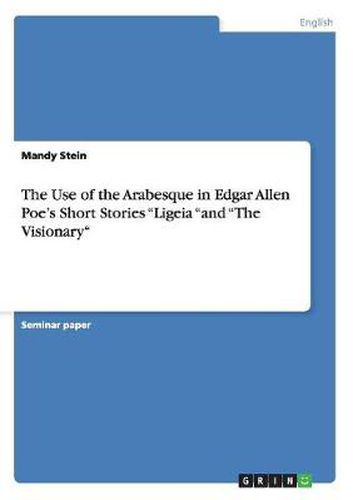The Use of the Arabesque in Edgar Allen Poe's Short Stories Ligeia and The Visionary
Mandy Stein

The Use of the Arabesque in Edgar Allen Poe’s Short Stories Ligeia and The Visionary
Mandy Stein
Seminar paper from the year 2007 in the subject American Studies - Literature, grade: 2,3, University of Goettingen, 16 entries in the bibliography, language: English, abstract: And the raven, never flitting, still is sitting, still is sitting On the pallid bust of Pallas just above my chamber door; And his eyes have all the seeming of a demon that is dreaming, And the lamp-light o'er him streaming throws his shadow on the floor; And my soul from out that shadow that lies floating on the floor Shall be lifted – nevermore! (Poe 28) These famous lines are from an often quoted poem by Edgar Allen Poe, one of the most famous American Authors of all time. He was a writer of all kinds of literary genre but well know for his mystery or detective stories. Who does not know The Tell-Tale Heart or was shocked by the horror in The Fall of the House of Usher ? Poe was a magnificent writer of Gothic Novels and is still today a well-known and well referred author when it comes to horror or even science fiction. His stories and plays are often adopted for the theatre and also Hollywood is incapable of not portraying his well-known horror stories. Next to his famous works Poe, like many authors of the 19th century, wrote arabesque stories. Although there is his known Collection of Arabesque and Grotesque Stories from 1840, it is unknown to many that he followed truly an oriental writing tradition and set footprints into this new genre like Johnson, Moore, Byron and others and developed the arabesque term to a new limit. But the question is if these stories are really written in the oriental tradition. Many critics are unsure up to this day if Poe really wanted to write in the arabesque or grotesque tradition and if he was aware of the fact that these two terms are of different background and do not, like many people think, just refer to the same definition. This term paper will focus on Poe’s use of the arabesque tradition in his stories The Visionary from 1834 and Ligeia
This item is not currently in-stock. It can be ordered online and is expected to ship in approx 2 weeks
Our stock data is updated periodically, and availability may change throughout the day for in-demand items. Please call the relevant shop for the most current stock information. Prices are subject to change without notice.
Sign in or become a Readings Member to add this title to a wishlist.


